


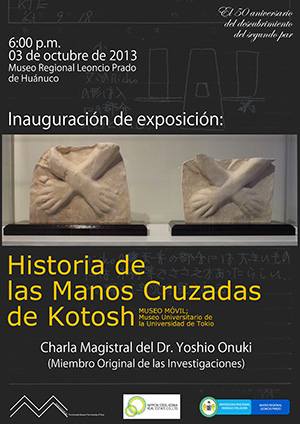
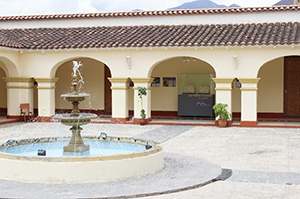
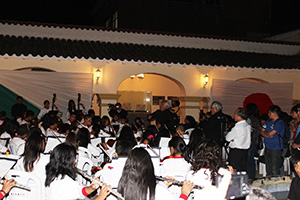
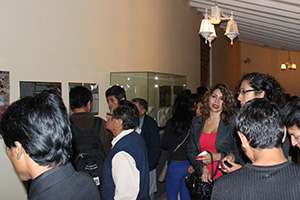
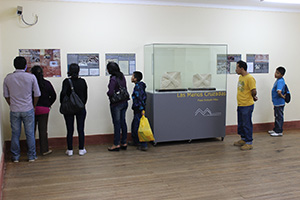
国立ワヌコ大学附属博物館
Historia de las Manos Cruzadas de Kotosh:
コトシュ遺跡「交差した手」の歴史
2013年10月3日〜
ワヌコ県、ワヌコ市、国立ワヌコ大学附属博物館
1960年代、泉靖一教授(教養学部文化人類学教室、1915年生〜1970年没)率いる東京大学アンデス地帯学術調査団は、ペルー共和国ワヌコ県ワヌコ市のコトシュ遺跡において3回にわたり発掘調査を実施した。その重要な成果のひとつが、遺跡の最下層から土器を伴わず出土した「コトシュ・ミト期(紀元前2500-1800年)」の神殿群の発見である。これらは当時の定説をくつがえし、「アンデス文明においては神殿建築の登場が土器製作技術の導入に先立つ」ということを証明するデータであった。それらの神殿のひとつの内壁を飾っていた、「交差した手」と名付けられた2点の粘土製レリーフの発見(1点目は1960年、2点目は1963年)はペルー社会に広く報道された。
交差した手はアンデス文明最古の美術の代表例として頻繁に言及され、とくに地元ワヌコでは地域のシンボルとして親しまれている。しかし1点目の「男の手」が心ない訪問者の手で破壊され、2点目の「女の手」が保存のために切り取られて首都リマに移送されてから、この文化遺産に関してワヌコ市民の記憶は薄れ始めた。今日では、調査団長の名は「セイイチ・イズミ通り」という街路名によってよく知られており、コトシュ遺跡は人々の憩いの場となっているものの、その研究の内容と意義について正確に知っている市民ばかりとは言えない。そして交差した手がなぜワヌコに現存しないのか、現在どこでどのようになっているのかについて、年月とともに事実を曲解した数々の噂話が生み出されてしまった。こういった状況を懸念し、また「女の手」発見50周年ということも考慮して、ワヌコ市にてモバイルミュージアムを企画するにいたったのである。
東京大学総合研究博物館の文化人類部門にはアンデス調査団初期の資料が収蔵されており、その中に一対の「交差した手」の石膏製レプリカ、およびその原型となった石膏型がある。「男の手」は発掘現場で壁面から直接、「女の手」は壁から切り出したあとに、いずれも型が起こされていたのである。とくに壊されてしまった「男の手」については、この型がオリジナルの形状を伝える唯一の貴重な資料といえる。本館ではペルーでのモバイルミュージアムのために、これらの型をもとにして交差した手の粘土製レプリカを新たに一対製作した。
「コトシュ遺跡『交差した手』の歴史」というタイトルは、先スペイン期に関する考古学的な知見にとどまらず、その発見の経緯や現在の状況までを念頭に置いたものである。そのため考古学の知識のみならず、調査者たちのエピソードや、手書きの調査日誌やさまざまな情景の写真など、フィールドワークの様子を物語るさまざまな情報がパネルに盛り込まれた。これらの資料は当館に保管されているが、過去にほとんど公開されてこなかったものである。また2つのレリーフの辿った運命や、型とレプリカの重要性についての解説が設けられた。レプリカとはいえ、男女の手が一堂に揃うということの歴史的な重要性に、来館者の思いは及ぶであろう。
会場となったのは「交差した手」を校章に掲げる、国立ワヌコ大学の附属博物館である。当時大学院生として発掘に参加していた大貫良夫名誉教授(本館終身学芸員)による講演会は聴講者数200人を越し、博物館講堂は2階まで人があふれかえった。さらに学童のオーケストラ・合唱団を加え、博物館中庭で盛大に除幕式が執り行われた。序幕式の翌日より館内の展示室のひとつがこのモバイルミュージアムのために割り当てられたので、今後も随時内容を拡充していく予定である。
鶴見英成(本館助教、アンデス考古学・文化人類学)
企画:東京大学総合研究博物館、国立ワヌコ大学附属博物館
製作:鶴見英成
協力:国立ワヌコ大学、セサル・サラ・レペト(ペルー・カトリカ大学有資格考古学者、国立ワヌコ大学附属博物館補助学芸員)、大貫良夫(東京大学名誉教授・本館終身学芸員)
後援:新日鉄興和不動産
[Español]
Historia de las Manos Cruzadas de Kotosh
A partir de 3 octubre de 2013
Museo Regional Leoncio Prado de la Universidad Nacional Hermilio Valdizán, Ciudad de Huánuco, departamento de Huánuco
En la década de los años 1960 la Expedición Científica de la Universidad de Tokio a los Andes dirigida por Seiichi Izumi (profesor del Departamento de Antropología Cultural, 1915-1970) ejecutó tres temporadas de excavaciones en el sitio arqueológico de Kotosh, ciudad de Huánuco, departamento de Huánuco, Perú. Uno de los resultados más importantes fue el descubrimiento de los templos de “la Fase Kotosh Mito (2500-1800 a.C.)” hallados en los niveles más profundos del sitio y caracterizándose por la ausencia de fragmentos de cerámica asociados a ellos. Estos datos evidenciaron que, a pesar de la teoría establecida en la época de investigaciones, la aparición de los centros ceremoniales más antiguos en la Civilización Andina precedió a la introducción de tecnología cerámica. Los descubrimientos de dos altorrelieves de arcilla denominados “las Manos Cruzadas”, la primera pieza en 1960 y la segunda en 1963, que adornaban las paredes interiores de uno de dichos templos fueron reportados ampliamente a la sociedad peruana.
Las Manos Cruzadas frecuentemente se refieren como piezas representativas del arte más temprano de los Andes y especialmente en Huánuco la gente tiene mucho cariño hacia ellas, y las ven como símbolos de su tierra. Sin embargo, después la destrucción de la primera pieza “(manos de) Hombre” causada por visitantes sin corazón y el traslado de la segunda pieza “(manos de) Mujer” a Lima para asegurar su conservación, ha flaqueado la memoria de los huanuqueños sobre este patrimonio cultural. Hoy en día, mientras el nombre del director del proyecto de aquella época es muy conocido gracias a la “Avenida Seiichi Izumi” y Kotosh es popular como un sitio recreativo, no muchos habitantes tienen conocimientos correctos sobre contenidos y significados de su estudio. Además, a lo largo de los años se han tejido muchas historias distorsionadas sobre el destino de las Manos Cruzadas; por qué no están en Huánuco, dónde y cómo están ahora. Considerando tal situación problemática, y también la conmemoración por el 50 aniversario del descubrimiento del par de manos de “Mujer”, se planteó la iniciativa del Museo Móvil en Huánuco.
El Departamento de Antropología Cultural del MUUT guarda materiales relacionados con los proyectos arqueológicos en los Andes desde sus primeros años, y entre ellos se encuentran una pareja de réplicas de yeso de las Manos Cruzadas, tomadas a partir de moldes del mismo material. El molde de “Hombre” fue tomado directamente desde la pared durante las excavaciones, y la de “Mujer” después de despegarla de su muro. Especialmente en cuanto al par “Hombre” que colapsó, su molde es muy preciado porque es el único material que evidencia la forma original. En el MUUT hicimos una nueva pareja de réplicas de las Manos Cruzadas, esta vez en arcilla, utilizando dichos moldes para la iniciativa del Museo Móvil en Perú.
El título “Historia de las Manos Cruzadas de Kotosh” cuenta su larga historia, desde la época antigua de la Fase Kotosh Mito hasta eventos recientes como su descubrimiento y las circunstancias de hoy. Por eso además de conocimientos arqueológicos, los paneles indican variedad de informaciones que describen la historia de los trabajos de campo como episodios de investigadores, diarios escritos a mano, además de fotos de varias escenas. Dichos diarios y fotos están archivados en MUUT aunque la mayoría no fueron publicados en el pasado. Las explicaciones sobre los diferentes destinos de los dos altorrelieves, y lo significativo de los moldes y replicas se han expuesto. Los visitantes podrán darse cuenta de la importancia desde el punto de vista histórico, de la colocación de los dos altorrelieves juntos, aunque sean réplicas.
La sede de la exhibición es el Museo Regional Leoncio Prado de la Universidad Nacional Hermilio Valdizán cuyo escudo contiene las manos Cruzadas. La charla dada por Yoshio Onuki (profesor emérito de la Universidad de Tokio, curador vitalicio del MUUT) quien participó en las excavaciones de Kotosh como estudiante de postgrado, atrajo más de 200 oyentes quienes llenaron los dos pisos de auditorio del museo. Además añadiendo números musicales interpretados por una orquesta y coro de escolares se celebró solemnemente la inauguración de la exposición en el patio del museo. Al día siguiente de la ceremonia una de las salas de exposición se asignó para el Museo Móvil; los contenidos van a extenderse gradualmente.
Eisei Tsurumi (arqueología andina, antropología cultural)
Planeado por MUUT (Museo Universitario de la Universidad de Tokio) y Museo Regional Leoncio Prado
Producido por Eisei Tsurumi
Cooperación con Universidad Nacional Hermilio Valdizán, César Sara Repetto (Pontificia Universidad de Católica del Perú, Curador Asistente del Museo Regional Leoncio Prado) y Yoshio Onuki (profesor emérito de la Universidad de Tokio, curador vitalicio del MUUT)
Auspiciado por Nippon Steel Kowa Real Estate Co., Ltd.
[English]
History of the Manos Cruzadas of Kotosh
From the 3rd of October of 2013
Regional Museum Leoncio Prado of the National University of Hermilio Valdizán, Huánuco City, department of Huánuco
In the 1960s the Scientific Expedition of the University of Tokyo to the Andes which was directed by Seiichi Izumi (professor of the Department of Cultural Anthropology, 1915-1970) excavated for three field seasons in the archaeological site of Kotosh, Huánuco City, Department of Huánuco, Peru. One of the important findings was the discovery of the temples of “Kotosh Mito Phase (2500-1800 BC)” unearthed in the deepest level of the site in which no pottery fragments were unearthed. This discovery became a proof data which changed the long accepted theory of the time to the fact that the building of the oldest ceremonial centers preceded the introduction of ceramic technology in the Andean Civilization. The discoveries of two clay relieves named “the Manos Cruzadas (the crossed hands)” which adorned the inner wall of the one of those temples, were reported to the public at large; the first piece was found in 1960 and the second one in 1963.
The Manos Cruzadas is frequently referred to as a representative piece of the earliest Andean art and the Huánuco inhabitants, especially, feel so much closeness as to call it the symbols of their region. However, after the first piece, “(Hands of) Man” was destroyed by some thoughtless visitors and the second piece “(Hands of) Woman” was transferred from the wall to Lima City for conservation, interest in and the remembrance of this cultural heritage among the residents of Huánuco began to fade away. Today, the name of the leader of excavation group is famous thanks to “Seiichi Izumi Avenue” and the Kotosh has become a place of recreation and relaxation for the citizens. But not so many citizens know the contents and significance of their research accurately. Moreover, with the passing of years many distorted rumors began circulating about the reason why the Manos Cruzadas do not exist in Huánuco, and where and what kind of condition they are now. In order to dispel all apprehensions regarding the two reliefs and to commemorate 50th anniversary of the discovery of the “Woman”, we planned to to have Mobile Museum in Huánuco.
The Department of Cultural Anthropology of UMUT owns the materials collected by the Andean archaeology projects from its earliest days, and among them there is a pair of plaster replicas of Manos Cruzadas originated from plaster molds. The mold of “Man” was made directly from the wall during the excavations and the mold of the “Woman” was made after cutting it off from the wall. Especially as to the “Man” that collapsed, the mold is very precious because it is the only material which shows the original form. In UMUT a new pair of clay replicas of the Manos Cruzadas was made utilizing these molds for Mobile Museum in Peru.
The title “History of the Manos Cruzadas of Kotosh” signifies their long history since the ancient period of Kotosh Mito Phase till present day taking into consideration such as the process of their discovery and circumstances. Because of its significance, the panels included not just archaeological information but also episodes of excavators, their handwritten diaries, various photos of sceneries, and other information that recount the situations of the fieldwork. These diaries and pictures are archived in UMUT but many of them were hardly published in the past. Commentaries were placed on the different destinies of the two relieves and the significance of the molds and replicas. The visitors of the museum will realize the significance of placing the two relieves side by side, even they are replicas, from the historical point of view.
The exhibition is held at the Regional Museum Leoncio Prado of the National University of Hermilio Valdizán whose school badge contains the Manos Cruzadas. The lecture was given by Yoshio Onuki (professor emeritus of the University of Tokyo, lifetime curator of UMUT) who participated in the excavations as a graduate student at the time, and more than 200 audiences attended to the lecture and swelled up to the second floor of the museum hall. The unveiling ceremony of the exposition was held on a grand scale at the patio of the museum with an orchestra and a chorus of schoolchildren. The day after the opening ceremony one of the exhibition room was assigned to Mobile Museum. We plan to expand its content gradually.
Eisei Tsurumi (Andean archaeology, cultural anthropology)
Planned by UMUT (University Museum, the University of Tokyo) and Regional Museum Leoncio Prado
Produced by Eisei Tsurumi
Cooperation with National University of Hermilio Valdizán, César Sara Repetto (Pontific University of Catholic in Peru, assistant curator of the Regional Museum Leoncio Prado) and Yoshio Onuki (professor emeritus of the University of Tokyo, lifetime curator of UMUT)
Supported by Nippon Steel Kowa Real Estate Co., Ltd.